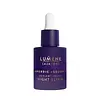What's inside
What's inside
 Key Ingredients
Key Ingredients

 Benefits
Benefits

 Concerns
Concerns

No concerns
 Ingredients Side-by-side
Ingredients Side-by-side

Water
Skin ConditioningGlycerin
HumectantCaprylic/Capric Glycerides
EmollientButylene Glycol
HumectantBetaine
HumectantVaccinium Vitis-Idaea Fruit Juice
Skin ConditioningNiacinamide
SmoothingVaccinium Vitis-Idaea Fruit Extract
AntioxidantVaccinium Vitis-Idaea Seed Oil
AntioxidantRubus Chamaemorus Fruit Extract
AntioxidantCalluna Vulgaris Flower Extract
Skin ConditioningCopper Heptapeptide-14 Pantothenate
Skin ConditioningHeptapeptide-15 Palmitate
Skin ConditioningPhenoxyethanol
PreservativePropanediol
SolventXanthan Gum
EmulsifyingTocopherol
AntioxidantHelianthus Annuus Seed Oil
EmollientEthylhexylglycerin
Skin ConditioningSodium Gluconate
Skin ConditioningSodium Hyaluronate
HumectantPentylene Glycol
Skin ConditioningHydrolyzed Hyaluronic Acid
HumectantAdenosine
Skin ConditioningCitric Acid
BufferingGluconolactone
Skin ConditioningCaprylyl Glycol
EmollientSodium Benzoate
MaskingPotassium Sorbate
PreservativeN-Prolyl Palmitoyl Tripeptide-56 Acetate
Skin ConditioningGlyceryl Caprylate
EmollientLactic Acid/Glycolic Acid Copolymer
Skin ConditioningPolyvinyl Alcohol
Phenylpropanol
MaskingRosmarinus Officinalis Leaf Extract
AntimicrobialCalcium Gluconate
HumectantParfum
MaskingCI 77491
Cosmetic ColorantWater, Glycerin, Caprylic/Capric Glycerides, Butylene Glycol, Betaine, Vaccinium Vitis-Idaea Fruit Juice, Niacinamide, Vaccinium Vitis-Idaea Fruit Extract, Vaccinium Vitis-Idaea Seed Oil, Rubus Chamaemorus Fruit Extract, Calluna Vulgaris Flower Extract, Copper Heptapeptide-14 Pantothenate, Heptapeptide-15 Palmitate, Phenoxyethanol, Propanediol, Xanthan Gum, Tocopherol, Helianthus Annuus Seed Oil, Ethylhexylglycerin, Sodium Gluconate, Sodium Hyaluronate, Pentylene Glycol, Hydrolyzed Hyaluronic Acid, Adenosine, Citric Acid, Gluconolactone, Caprylyl Glycol, Sodium Benzoate, Potassium Sorbate, N-Prolyl Palmitoyl Tripeptide-56 Acetate, Glyceryl Caprylate, Lactic Acid/Glycolic Acid Copolymer, Polyvinyl Alcohol, Phenylpropanol, Rosmarinus Officinalis Leaf Extract, Calcium Gluconate, Parfum, CI 77491
 Reviews
Reviews

Ingredients Explained
These ingredients are found in both products.
Ingredients higher up in an ingredient list are typically present in a larger amount.
Citric Acid is an alpha hydroxy acid (AHA) naturally found in citrus fruits like oranges, lemons, and limes.
Like other AHAs, citric acid can exfoliate skin by breaking down the bonds that hold dead skin cells together. This helps reveal smoother and brighter skin underneath.
However, this exfoliating effect only happens at high concentrations (20%) which can be hard to find in cosmetic products.
Due to this, citric acid is usually included in small amounts as a pH adjuster. This helps keep products slightly more acidic and compatible with skin's natural pH.
In skincare formulas, citric acid can:
While it can provide some skin benefits, research shows lactic acid and glycolic acid are generally more effective and less irritating exfoliants.
Most citric acid used in skincare today is made by fermenting sugars (usually from molasses). This synthetic version is identical to the natural citrus form but easier to stabilize and use in formulations.
Read more about some other popular AHA's here:
Learn more about Citric AcidGlycerin is already naturally found in your skin. It helps moisturize and protect your skin.
A study from 2016 found glycerin to be more effective as a humectant than AHAs and hyaluronic acid.
As a humectant, it helps the skin stay hydrated by pulling moisture to your skin. The low molecular weight of glycerin allows it to pull moisture into the deeper layers of your skin.
Hydrated skin improves your skin barrier; Your skin barrier helps protect against irritants and bacteria.
Glycerin has also been found to have antimicrobial and antiviral properties. Due to these properties, glycerin is often used in wound and burn treatments.
In cosmetics, glycerin is usually derived from plants such as soybean or palm. However, it can also be sourced from animals, such as tallow or animal fat.
This ingredient is organic, colorless, odorless, and non-toxic.
Glycerin is the name for this ingredient in American English. British English uses Glycerol/Glycerine.
Learn more about GlycerinPhenoxyethanol is a preservative that has germicide, antimicrobial, and aromatic properties. Studies show that phenoxyethanol can prevent microbial growth. By itself, it has a scent that is similar to that of a rose.
It's often used in formulations along with Caprylyl Glycol to preserve the shelf life of products.
Sodium Hyaluronate is hyaluronic acid's salt form. It is commonly derived from the sodium salt of hyaluronic acid.
Like hyaluronic acid, it is great at holding water and acts as a humectant. This makes it a great skin hydrating ingredient.
Sodium Hyaluronate is naturally occurring in our bodies and is mostly found in eye fluid and joints.
These are some other common types of Hyaluronic Acid:
Learn more about Sodium HyaluronateWater. It's the most common cosmetic ingredient of all. You'll usually see it at the top of ingredient lists, meaning that it makes up the largest part of the product.
So why is it so popular? Water most often acts as a solvent - this means that it helps dissolve other ingredients into the formulation.
You'll also recognize water as that liquid we all need to stay alive. If you see this, drink a glass of water. Stay hydrated!
Learn more about Water